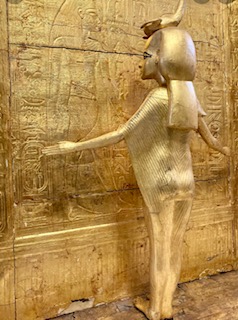
The Goddess Selket
Who is the Goddess Selket?
Well, she traveled through millennia and splashed into our consciousness in one remarkable moment, when the British archaeologist Howard Carter took his long awaited peek into the tomb of King Tut and said, “I see wonderful things.” It was at that moment when her rebirth was assured.
There she stood in this long forgotten tomb in the Valley of the Kings, majestically graceful with her widespread arms and delicately turned head, poised in powerful silence. And with her Goddess companions Isis, the Goddess of a Thousand Names, and her twin sisters Nephthys and Neith.
Selket stood guarding the East.
Here stood the ancient, shielding canopy overlaid with gold that was supported by four corner posts upon a massive sledge. Its cornice was surmounted with brilliantly inlaid solar cobras. And on each side was a lifelike, gilded statuette of a tutelary Goddess, guarding her charge with outstretched arms.
The central portion was a large shrine-shaped chest that was completely overlaid with gold and surmounted with a solar cobra concealing a smaller chest hewn out of a solid block of veined calcite that held the four receptacles of the viscera of the king, each wrapped separately and held in a miniature gold coffin.
In the Egyptian process of mummifying the body, the viscera were separately preserved in four receptacles associated with the genii Imsety, Hepy, Duaamutef, and Qebehsnewef, who were under the protection of Isis, Nephthys, Neith, and Selket.
Each of these four tutelary Goddesses was supposed to have possessed within herself a genius, which it was her duty to protect. Hence, we find Imsety guarded by Isis, and Hepy by Nephthys; the guardians of the Duaamutef and Qebehsnewef were Neith and Selket respectively.
 Copyright secured by Digiprove © 2022 Lady Haight-Ashton
Copyright secured by Digiprove © 2022 Lady Haight-Ashton